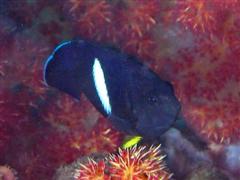Angelfish keyhole
Tibicen Angel Fish, Keyhole Pygmy Angelfish Scientific Name: Centropyge tibicen
Wed, 2nd July, 2025 - 6:26 pm GMT
Sponsor Ads:

Alternative Name
Tibicen Angel Fish, Keyhole Pygmy Angelfish Scientific Name: Centropyge tibicenBasic Info
Keyhole Angels can grow up to seven to eight inches long (18.5 to 20 centimeters) at maturity. They are given the name "keyhole" by the vertically elongated white blotch on the upper portions of their sides. Orange and blue accents may be present just in front of this keyhole blotch on their black body. Their dorsal, anal, and caudal fins have submarginal blue lines, and the lower part of the anal fin is yellow, demarcated from the black by a white line.
Health
An adult Keyhole Angel should be kept in an aquarium of at least 50 gallons in volume. The temperature should remain between 75 and 78 degrees Fahrenheit (24 to 26 degrees Celsius), with a pH of 8.3 to 8.4. The salinity should be kept between 1.020 and 1.023 for a single fish, though with the addition of invertebrates, it should remain between 1.023 and 1.025 for the health of these animals. Keyhole Angels may not tolerate fish of similar species. Keyhole Angel Fish should be fed a variety of foods.Habitat
Saltwater fish - Keyhole Angels are associated with reefs in the wild, though they are rarely found close to islands. They are normally found at depths between 4 and 55 meters.Behavior
The Keyhole Angel is one of the largest of its genus, normally known as the Dwarf or Pygmy Angels. Their activities and their striking color pattern can make them interesting captives. In captivity, the Keyhole Angel can be kept in a reef environment. However, these Angels may nip at other fish of the same or similar species, soft coral polyps, stony coral polyps, zoanthids, or tridacnid clam mantles. For this reason, they are not generally considered to be reef safe. They are know for being shy. Keeping them with non-aggressive and smaller tank mates may help them acclimate better to captivity.Origin
Indo-PacificHistory
Native to the Indo Pacific, their range includes parts of Australia, Taiwan, and Japan, in addition to the Moluccan, Philippine, and New Hebrides Islands. They are also found in the Indo-Australian archipelago, and are also collected for the pet trade in the Indian Ocean.Common Foods
Algae and other vegetable materials are offered in conjunction with mysis shrimp, spirulina, or other protein items. Live, frozen, and prepared formulated foods are also available to use with Keyhole Angels.Sponsor Ads:
"If he is taking his ease, give him no rest. If his forces are united, separate them." -- Sun Tzu, The Art of War
Angelfish keyhole
Coded by: BGID® | ALL RIGHTS RESERVED Copyright © 2000-2025
Disclaimer | Privacy | Report Errors / Contact | Credits
















